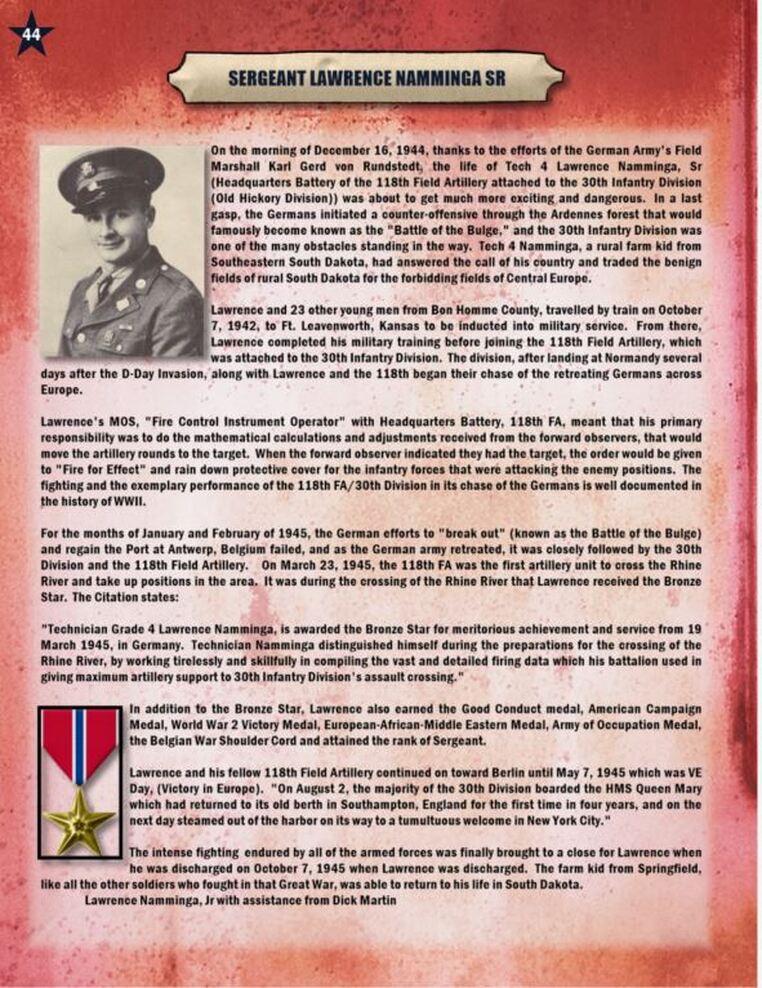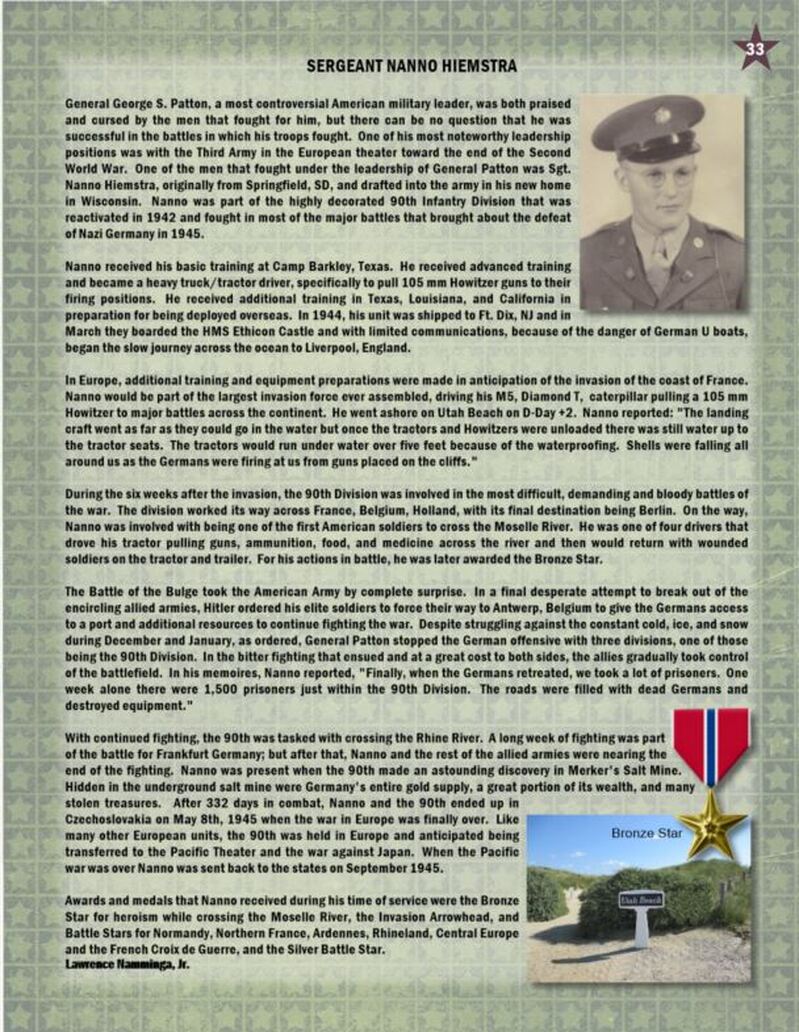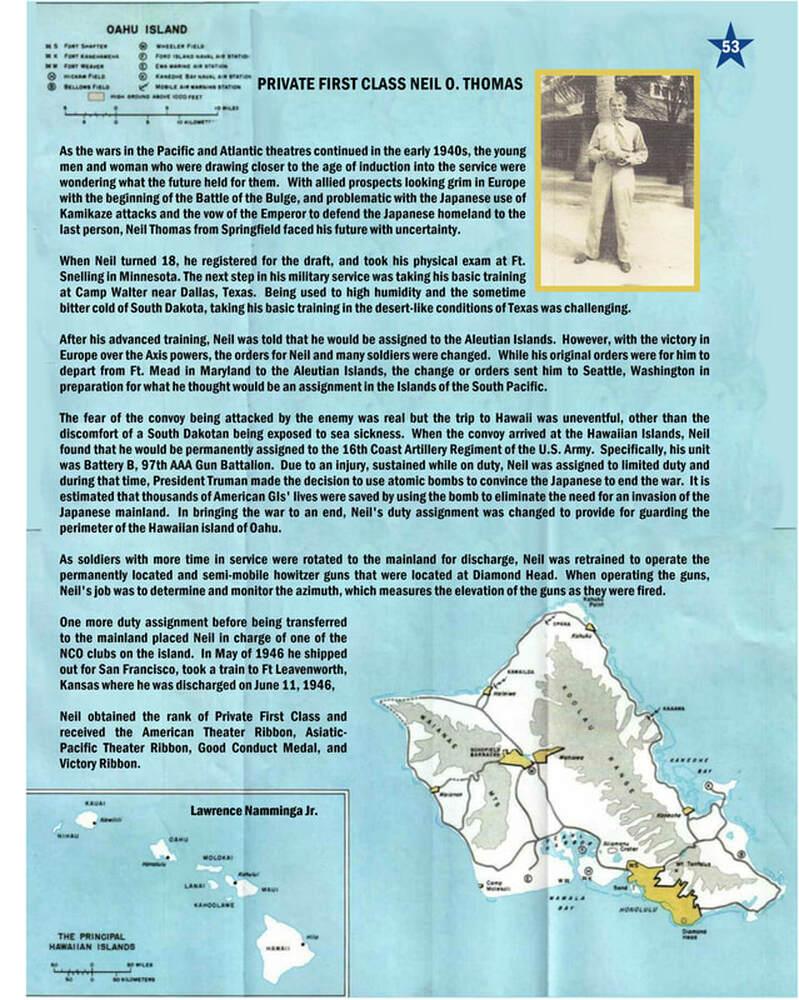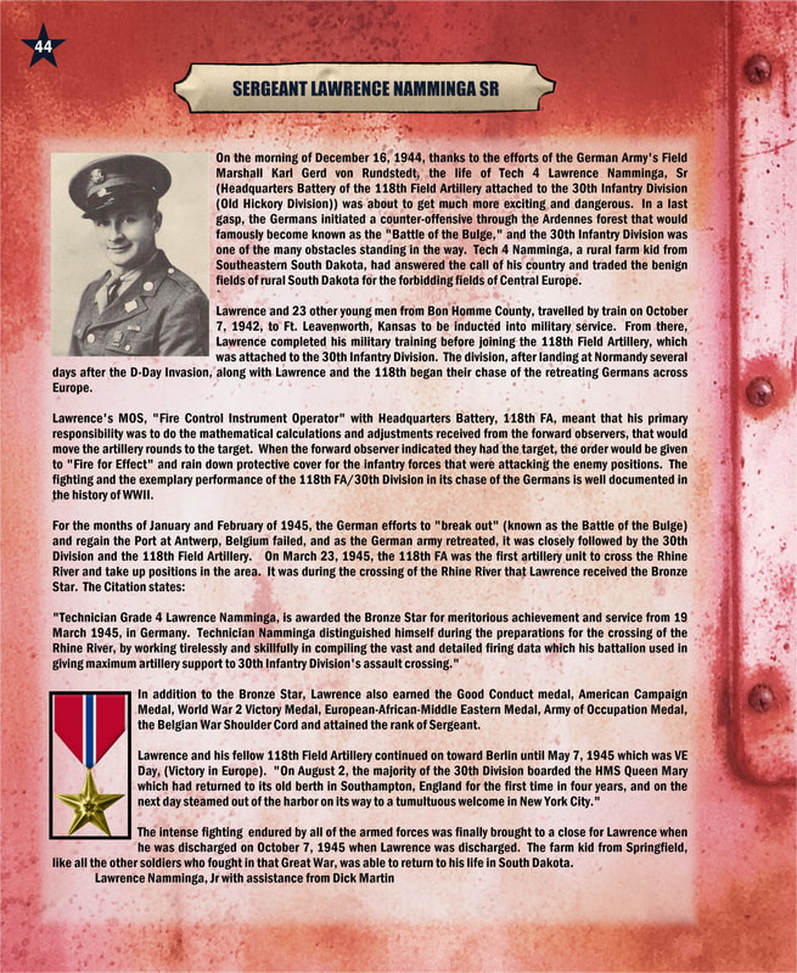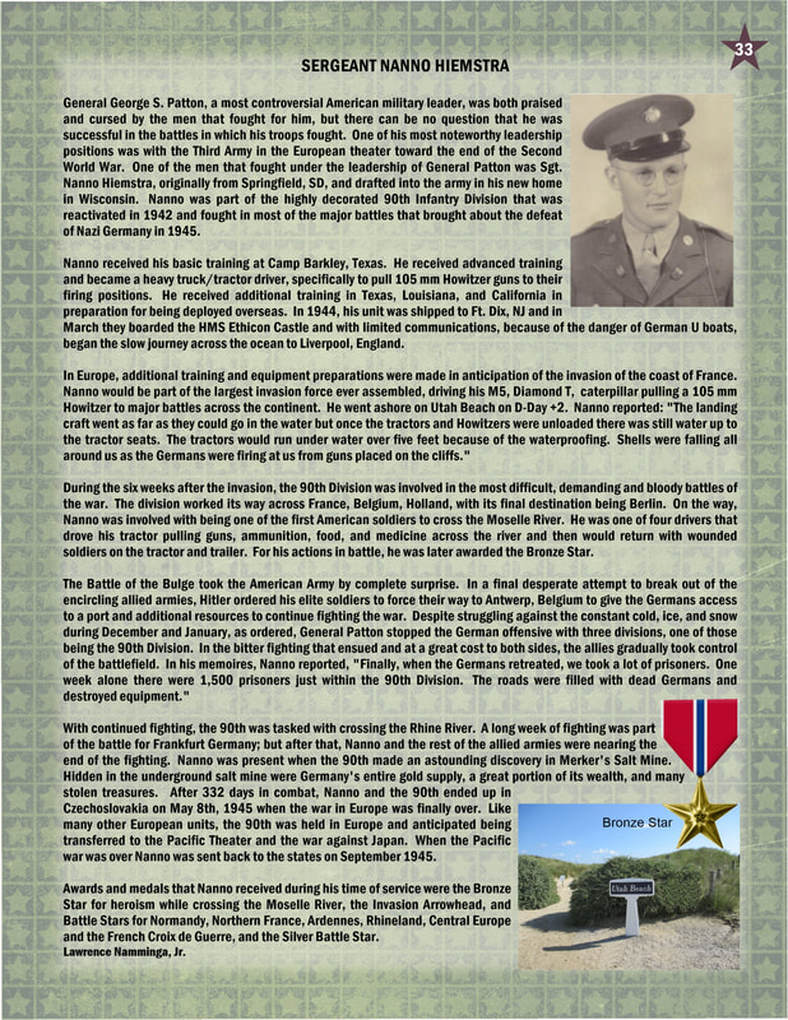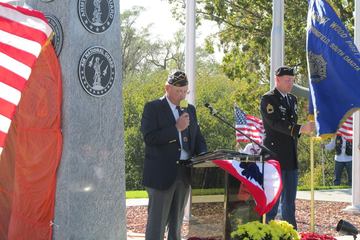|
By Lawrence Namminga Preamble by Dick Martin Like September 11, 2001 and December 7, 1941 South Dakotans have an extra day, June 10, 1972, that they will not forget and probably remember what they were doing that day. On that day, disaster struck as Canyon Lake Dam in the Black Hills failed after 15 inches of rain fell in six hours causing Rapid Creek to overflow and flood much of Rapid City causing 238 deaths, 3,057 injuries, and 160 million in property damage. Rapid city needed help and the rest of South Dakota answered the call. Springfield did its part when many of its citizens, as part of Company D of the 153rd National Guard Engineer Battalion, joined the effort in contributing to the recovery operations in Rapid City. To quote President Franklin Delano Roosevelt, “A date that will live in infamy.” That quote could be used by South Dakotans as it is applied to the June 9, 1972 flood in Rapid City, South Dakota when 238 people lost their lives in the “Rapid City Flood”. For me, the emergency started after a day of working in the hay fields outside of Cody, NE, and my wife Cheri and I loading up the car and heading to Springfield for a night’s rest in preparation for the June guard drill of Company D, 153rd Engineer Battalion in Springfield the next morning. When leaving Cody, I remember commenting to Cheri that the Thunder Heads really were quite large to the west, even though we were 140 miles SE of the Black Hills.
We got to bed by 11:30 in my parents’ home and at 1:30 my dad woke me up and told me that I needed to report to the armory immediately. Little did I know that my two hours of sleep would be all that I would receive for the time covering the 48 hours prior and after my call up. Upon arriving, I heard that our unit and all of the National Guard units in the state, had been activated because of a flood in the Rapid City area. We had no idea of just how serious it really was. As guard members started to arrive, trucks were loaded with all of our equipment in preparation for the trip to the Hills. The unit proved to itself just how important readiness was in that it enabled us load all of the unit’s equipment that was stored in the armory in a very short amount of time. Most of the rest of Company D personnel had arrived by 5:00 a.m. and we were loaded and moved out of Springfield shortly after sunrise on our trip to Rapid City. The trip out was uneventful and those of us that had transistor radios with us tried to listen to news reports that gave us a clue as to what we were facing. (We sometimes forget just how advanced communication and instant news reports are today as compared to 40 years ago; we really were in the dark!) Disbelief is the best word to describe what we were hearing on damage done and the lives lost and/or missing in those brief snippets of news coverage. When we got past the Ellsworth Air Force Base exit on Interstate 90, we began to see just how violent the flood must have been. Several sections of the interstate had been washed away and destroyed and water was still moving rapidly in the affected creeks, but nothing could prepare us for what we saw when we entered Rapid City. Before I begin the narrative of the 153rd’s time in Rapid City starting with the day after the flood, I need to emphasize the volume of traffic that was coming into the city by the National Guard convoys and other relief vehicles. The 153rd Engineer Battalion, of which the Springfield Unit was a part, was composed of five companies, A, B, C, D and Headquarters Company. Each of the companies probably had 20+ vehicles of various National Guard system in place that is responsible to the governor for disasters that can arise. There are so many interesting and tragic stories that I did not personally witness, but have heard from National Guard personnel that were present during the flood that tell of heroism, persistence, and tragedy. A friend, who happened to be in Rapid City at the time, witnessed the water rising around his car in the intersection while he waited for the light to change. He got through the intersection and was able to get to high ground, but he watched the car right behind him get washed away in Rapid Creek. He was listed as missing for two or three days until he finally got word that he was on the missing person’s list and got the error corrected. The entire experience in Rapid City will never be forgotten and I am very proud that our National Guard unit was able to be a part of the recovery operations. By Major Tim Diede Photos by Lawrence Namminga 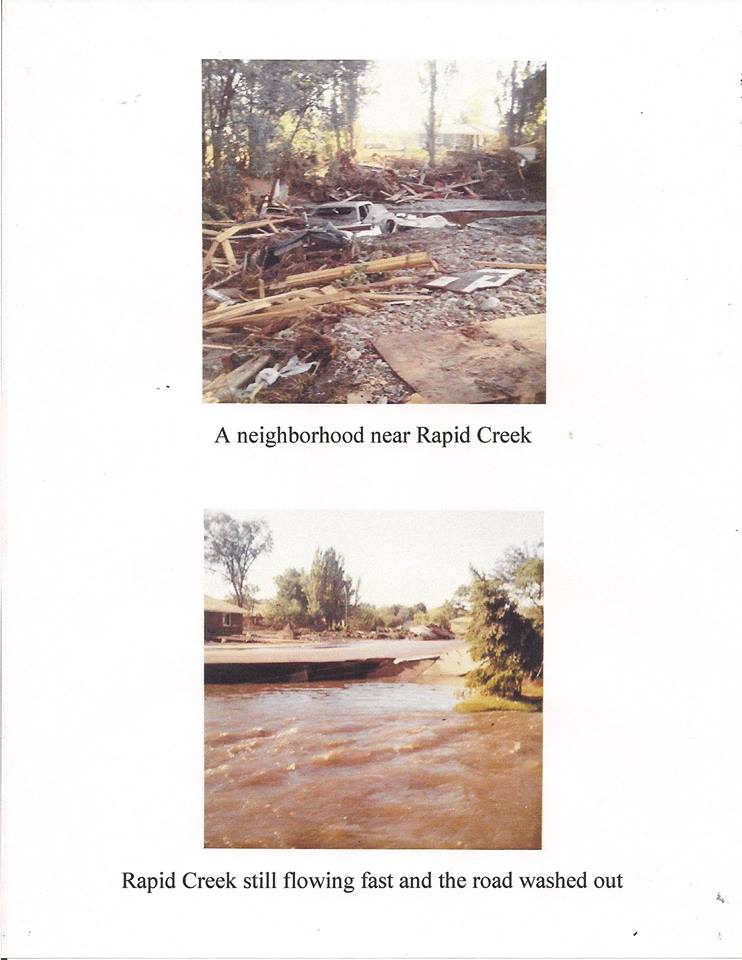 Recollection of Springfield’s Company D and the Rapid City Flood of June 1972 Disaster mobilization for the Rapid City, SD flood was one of the missions Co D responded to in the history of the unit. For me, mobilization started with a phone call early in the morning and finding myself in the Springfield armory at about 0500 with fellow members of the unit. Unit members were trickling in from throughout the area and everyone was trying to discover what was going on as not too much was known at this point except there had been a flood and we needed to get to Rapid City. At about 0530 my squad leader Sgt. Louis Cowherd hastily told me and several fellow soldiers that we were to load up and take off immediately as the “Advance Party” for the unit. We were off to Rapid City with a halt at the Wasta rest stop for fuel and then arrived at the Group Headquarters site by noon. Our mission as Advance Party was to prepare a site for the arrival of the rest of the members of Co D and our equipment. This task involved the securing of a location for personnel and equipment and locating the various supply points for food, fuel and so forth that we would need to support the mission. This seemed like a huge task as many of us had never been to Rapid City and our group made up mostly of “young” Privates and Spec 4’s were overwhelmed with all the activity at the Group Headquarters when we reported in. We young soldiers did not have to wait long to find out what we were to do. Returning from a meeting Sgt. Cowherd had me report directly to the mess sergeant SFC Charles Dawes. I reported to SFC Dawes who gave me the task of digging a grease pit for the kitchen and said he’d be by to inspect it later. After about an hour SFC Dawes came to inspect the grease pit and after sharing some of the finer points of grease pit construction he departed and I proceeded to complete the grease pit to specification. Other members of the advance party were assigned similar kitchen police (KP) duties. Anticipating a busy day with search and rescue we ended a long day by preparing to feed our fellow members of Co D when they arrived later in the evening. As the day ended so did the mission for the advance party of Company D. Before I begin the narrative of the 153rd’s time in Rapid City starting with the day after the flood, I need to emphasize the volume of traffic that was coming into the city by the National Guard convoys and other relief vehicles. The 153rd Engineer Battalion, of which the Springfield Unit was a part, was composed of five companies, A, B, C, D and Headquarters Company. Each of the companies probably had 20+ vehicles of various sizes and styles. Jeeps, dump trucks, cargo deuce & a half, five ton trucks pulling caterpillars and other heavy construction equipment were entering Rapid City. There were probably another four or five Battalions that were also arriving in the city at the approximate same time, so getting everyone to their assigned areas was a major endeavor. Added to that, Camp Rapid already had quite a few Guard Units bivouacked there because their two-week annual training had already begun. When we arrived within the city limits of Rapid City, we were escorted to our bivouac area, high and dry in the western part of Rapid City. We were escorted because there still wasn’t any electricity within Rapid City proper and in many cases no traffic lights that were operable even if electricity were available. On our way to the bivouac area we encountered mud, dirt, downed trees, and so many cars and trucks that were overturned, stacked against each other, and covered with mud. I found one car unusual, in particular, because it was resting on the back bumper and the front was resting high on a light pole. It was only the next day that we found out that when the car was removed there were bodies inside. When we arrived at the bivouac area, we started to set up camp. Since, at that time, I was assigned as a cook in the mess section, we immediately began to set up the outdoor kitchen, but if I remember correctly. our first night’s meal was C rations, as food wasn’t available at that late hour. Still, another cook and I went to several of the big grocery stores in the Rapid City area so that we would be able to provide a good breakfast to start the next day. We needed to get enough provisions to get us by until the National Guard’s supply system was able to provide us what we needed. One grocery store, in particular, was very helpful as it urged us to take a lot of perishable items since they would probably spoil if they couldn’t get rid of them soon. Our unit spent a great deal of time looking for bodies, the destruction and hauling away of destroyed houses and debris, and assisting in whatever ways we were called on to assist local authorities reestablish a semblance of order in a unprecedented disaster. For some reason, as I was leaving Springfield, I had thrown a camera and several rolls of film in my duffel bag. I still have those photos as a reminder of how nature can throw disasters our way at the most unexpected times. It is good that each state has a well prepared National Guard system in place that is responsible to the governor for disasters that can arise. There are so many interesting and tragic stories that I did not personally witness, but have heard from National Guard personnel that were present during the flood that tell of heroism, persistence, and tragedy. A friend, who happened to be in Rapid City at the time, witnessed the water rising around his car in the intersection while he waited for the light to change. He got through the intersection and was able to get to high ground, but he watched the car right behind him get washed away in Rapid Creek. He was listed as missing for two or three days until he finally got word that he was on the missing person’s list and got the error corrected. The entire experience in Rapid City will never be forgotten and I am very proud that our National Guard unit was able to be a part of the recovery operations. Submitted by Lawrence Namminga, Jr.
When you look back on every war and conflict that our country has been part in there are those that perhaps because of legitimate health conditions, or they were working in a job vital to the defense of our country that in their own way “served” with a full sense of devotion. While my father served with the 30th division “Old Hickory” in Europe and in the Battle of the Bulge, and his brother served and another uncle served in the Pacific theatre in World War II, another of my father’s brothers was not allowed to serve in the armed forces and stayed and farmed to raise the food, etc. that was a vital contribution to the war effort. We have all heard the stories of “Rosie the Riveter”, and the WAFS, female aviators who flew every aircraft that the men were flying, and while at that time they did not fly in combat situations, there was still danger involved and they were doing a job that freed up young men to fly and fight in those combat theatres. Did they love their country any less? Wasn’t their work also a service to this great country? As I looked over the information that was given to me concerning speaking on Memorial Day I noticed that it suggested “speeches be strictly in the nature of a tribute to, or eulogy of, the dead in all our wars”. It reminded me of a comparison that I had made in this very spot several years ago as presented a program for Veteran’s Day. In the fall of the year we honor our Veterans with a special day called Veterans’ Day. Honoring them for their commitment to service. But Memorial Day is just a little different in that it is a day to remember those who have given their lives and have made the ultimate sacrifice. We should all remember the origins of Memorial Day. You mention it during this program. Within several years after the conclusion of the War between the States, several different communities in the North and the South wanted to hold a special day to remember their “own”. Much in line with Lincoln’s Gettysburg address while the war was still going on, it was a way to honor all those who had died. As Lincoln said, “It is altogether fitting and proper that we should do this. . . that these . . . . should not have died in vain.” Gen. Logan, commander in Chief of the Grand Army of the Republic said.”. . . .. . . .. “ So we have a long record of honoring those that gave their lives in service to our country. While I in no way want to deemphasize the importance of honoring the veterans who served, we must do that every year, we must remember them with a sense of true patriotism, I sometimes think that we should not overlook the importance of others who have served in other capacities during these times of national emergency. Yes, it is not only appropriate that we speak about the veterans of all of our “Wars” but it got me to thinking about the words of Pres. Bush and other leaders who want every single American to realize that we are in a War again. A war like none that we have ever been in before. That in turn got me to compare this “new war” and other wars of the past and to think about giving tribute to all people that have SERVED. When you concentrate on that one section, ‘THOSE WHO SERVED”, it brings to light an additional opportunity that we have to honor those people. To emphasize my point I want to relate to you several stories. The first is: In the summer of 1942 a small, single engine, two place civilian airplane is flying patrol over the Atlantic ocean approximately 25 miles off the coast of Atlantic City, NJ. After the United States had entered the second world war against Germany, a very real threat was from submarines attacking ships off the coast of the United States. The Navy and Coast Guard ships and aircraft were in short supply so a group of volunteers offered their time and aircraft to guard our coastline. Suddenly the aircraft spots a German submarine and notifies headquarter at the airfield in Atlantic City. Shortly after the notification, another civilian aircraft, a Grumman Widgeon, piloted by Johnny Haggins and Wynnant Farr takes off. This is a larger airplane and has been fitted with “dept charges”. It flies to the last known position of the submarine and begins its search. From the air, even though the submarine is submerged its “outline” can be seen under the water and so that aircraft now takes up the chase. (The rest of the story is that they did eventually sink the submarine!) Why would a group of people such as these with the new volunteer organization called the Civil Air Patrol put themselves in harms way? For the same reason that thousands upon thousands of American men and women have worked in many ways for the service of our country. The Second is from a more familiar event, and that is of the acts of terrorism on 9-11. That is when police officers, firefighters, EMTs, doctors, and civilians ran toward the carnage and performed acts of heroism that sounded like events you read about in times of war. Trying to pick out just one story of a hero is daunting---there are so many. But here is one. NYPD Officer Moira Smith was the first officer to report the terrorist attacks of September 11, 2001 when she saw the first plane strike the first tower of the World Trade Center. Smith, a 13-year veteran, ran into the towers and began assisting in the evacuation. Her coolness under pressure was remembered by a survivor, Martin Glynn: "The mass of people exiting the building felt the calm assurance that they were being directed by someone in authority who was in control of the situation. Her actions even seemed ordinary, even commonplace. She insulated the evacuees from the awareness of the dangerous situation they were in, with the result that everything preceded smoothly." Officer Smith is credited with saving hundreds of lives that day, giving her own in the process. She was the only female NYPD officer to die on 9/11. She was survived by her 2-year-old daughter and her husband. Another prime example of “giving your life for your country” would be the example of the hero’s on Flight 93 who prevented the terrorists from flying that airplane into the White House or the Capital on 9/11 by crashing it to the rural countryside of Pennsylvania and in so doing, sacrificed their lives. We need to raise up and remember the members of our military who gave their lives, and continue to give their lives, in service to this the greatest country on earth. But let us also remember and honor the civilian members, though not carrying a gun in a conflict, that are still part of the team that makes up the United States of America. |
Categories
All
Archives
October 2023
|
